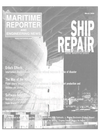
Japan: Advanced procedures sustain industry in turbulent markets
Japan retains its perch atop the world commercial shipbuilding heap, although its position grows increasingly precarious with the continued emphasis on shipbuilding market share by its Korean competitors, and the emergence of lowcost, hungry start-ups in China and the former Eastern bloc nations.
The challenges facing the Japanese shipbuilders and ship equipment suppliers are not unlike those faced by its European counterparts during much of the past decade. While Japan's strong suit continues to be its ability to mass produce tankers and bulk carriers in a very efficient and profitable manner, its technical prowess and continually refined manufacturing procedures can only take it so far in what continues to be a labor intensive process. The proliferation of and widespread incorporation of advanced shipbuilding CAD/CAM/CAE systems continues to level the playing field, as upstarts and industry veterans alike are a major investment away from drastically increased efficiencies.
While the balance of power in commercial shipbuilding continues to tip away from Japan, the home countries' voracious appetite for new ships continues to drive new business.
In fiscal 1998 (the last official statistics available at press time), new orders received by Japanese shipbuilders totaled 283 vessels equaling 10.5 million gross tons, a decrease of 35.4 percent in the number of vessels and 21.4 percent in GT from FY 1997. Dry Cargo (5.7 million GT) and Tankers (4.8 million GT) dominated the newbuild orderbook, with just 36,000 GT dedicated to the category "other." Worldwide, it is worthy to note, orders for newbuildings worldwide were 26.7 million GT, down 10 million GT from 1997.
Even more telling is the value of ship machinery produced and exported. Of the nearly 870.1 billion yen ($6.8 billion) of ship machinery produced in 1998, a dominating $6.4 billion worth was manufactured for use in Japan. In comparison, Japanese shipbuilders imported a scan (in comparison) $184 million worth of ship machinery in 1998, a decline of seven percent from the year before, according to figures from the Japanese Marine Equipment Association.
While the Japanese ship equipment supply business is clearly dominant on its home grounds, the recent deterioration of newbuilding activity has left the collective industry — which boast approximately 775 factories and about 35,000 workers — with some notable problems of its own. For example, the proliferation of low-cost competitors and stagnation of R&D activities has weakened the very foundation of the Japan ship machinery industry. In an effort to reverse this trend, there has been a recent upsurge in the vital ization of R&D activities within these vital manufacturers, with the realization that the new market realities include shortages of both skilled workers and engineers, coupled with fewer funds earmarked for R&D. The call has also been sounded for manufacturers to immediately strengthen its cost competitiveness by modernizing production facilities and improving productivity through additional automation and procurement of low-cost materials, as well as the reduction of the number of parts used in machinery and equipment.
Other stories from March 2000 issue
Content
- A broader-based payback from R&D page: 8
- An Effective Shield from Criminal Prosecution page: 14
- MARCO Signs Contract With S.F. Bar Pilots page: 16
- MAN Acquires Alstom Diesel Engine Ops page: 16
- South Korean January Ship Orders Increase page: 17
- Dockwise Awarded Hanjung Contract page: 17
- The U.S. Navy - Reducing Shipboard Planned Maintenance page: 20
- Safety Charter Targets Old Tankers, Flags Of Convenience page: 20
- High Times Again in Singapore? page: 22
- Ship Repair Yards Ask: Where's the Funding? page: 26
- Ailsa-Troon Continues To Climb page: 27
- Irving Shipbuilding Repairs Wide Selection page: 29
- Vessels Make Pit Stop At Bay Ship page: 30
- Tampa Bay Shipbuilding - Gearing Up For A Boom page: 31
- Bollinger Puts Its Expertise To The Test page: 32
- Turbo-Technik: Rescuing A "Prinsesse" page: 33
- Smooth Sailing page: 34
- Seacoast Delivers Package To Halter page: 34
- JRC Radar Offers Plotter System page: 34
- SKYbolt Enables Real Time Processing page: 38
- Transas Moves Towards Auto Integrated Navigation page: 44
- Litton To Supply For New Passenger Ferries page: 44
- Riverboat Casino Ratings Buoyed by Regulations, Demand page: 48
- Washburn & Doughty: Developing New Process To Meet Changing Needs page: 49
- Fictitious Tugboat Character Goes Live In Canada Yard page: 51
- Bollinger opts for Oracle page: 52
- BIMCO Introduces Millennium Software page: 55
- Ship Safety Database Set Up To Avoid Future Disasters page: 55
- WindShip Technology Promises Fuel Saving s page: 56
- Recore Classified As Fireproof For Vessels page: 56
- Sandwiched Composites Offer Promise For Marine Industry page: 57
- Fiberline Offers GRP For Use In Hostile Environs page: 57
- AMT Marine To Construct Utility Boat page: 59
- Sneed Delivers Pushboat To Blessey Marine page: 59
- Alert in Valdez Harbor page: 60
- 3.MAJ Delivers Innovative Tanker page: 61
- Robert Allan Design To Be Built For Brusco page: 62
- New Surface Cleaning Process Saves Navy On Maintenance page: 65
- Jotun Goes Tin-Free page: 66
- Se-Cliff Enhances With CoreKote 2000 page: 69
- Japan: Advanced procedures sustain industry in turbulent markets page: 74
- JAMSTEC Deepsea Exploring Ship Contract Announced page: 75
- Power management with distributed intelligence page: 76
- Chamber Of Shipping Requests Entries page: 77
- The Erika oil spill - using the incident to positive effect page: 80
- NCL Board Dumped, Lund Appointed page: 92
- Litton Integrates Marine Ops In New Company page: 92

